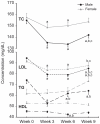Cardiometabolic risk in US Army recruits and the effects of basic combat training
- PMID: 22384004
- PMCID: PMC3285625
- DOI: 10.1371/journal.pone.0031222
Cardiometabolic risk in US Army recruits and the effects of basic combat training
Abstract
Background: Cardiometabolic disease risk in US military recruits and the effects of military training have not been determined. This study examined lifestyle factors and biomarkers associated with cardiometabolic risk in US Army recruits (209; 118 male, 91 female, 23 ± 5 yr) before, during, and after basic combat training (BCT).
Methodology/principal findings: Anthropometrics; fasting total (TC), high-density lipoprotein (HDL) and low-density lipoprotein (LDL) cholesterol; triglycerides (TG); glucose; and insulin were measured at baseline and every 3 wks during the 10 wk BCT course. At baseline, 14% of recruits were obese (BMI>30 kg/m(2)), 27% were cigarette smokers, 37% were sedentary, and 34% reported a family history of cardiometabolic disease. TC was above recommended levels in 8%, LDL in 39%, TG in 5%, and glucose in 8% of recruits, and HDL was below recommended levels in 33% of recruits at baseline. By week 9, TC decreased 8%, LDL 10%, TG 13%, glucose 6% and homeostasis model assessment of insulin resistance (HOMA-IR) 40% in men (P<0.05). In women, TC, LDL, glucose and HOMA-IR were decreased from baseline at weeks 3 and 6 (P<0.05), but were not different from baseline levels at week 9. During BCT, body weight declined in men but not women, while body fat percentage declined in both men and women (P<0.05).
Conclusions/significance: At the start of military service, the prevalence of cardiometabolic risk in US military recruits is comparable to that reported in similar, college-aged populations. Military training appears to be an effective strategy that may mitigate risk in young people through improvements in lipid profiles and glycemic control.
Conflict of interest statement
Figures


References
-
- Heron M, Hoyert DL, Murphy SL, Xu J, Kochanek KD, et al. Deaths: final data for 2006. Natl Vital Stat Rep. 2009;57:1–134. - PubMed
-
- Keenan NL, Shaw KM. Coronary heart disease and stroke deaths - United States, 2006. MMWR Surveill Summ. 2011;60(Suppl):62–66. - PubMed
-
- Carroll MD, Lacher DA, Wolz M, Sorlie PD. 30-year trends in serum lipids among United States adults: results from the national health and nutrition examination surveys II, III, and 1999–2006. Am J Cardiol. 2011;107:1868–1870. - PubMed
-
- Li C, Ford ES, Tsai J, Zhao G, Balluz LS, et al. Serum non-high-density lipoprotein cholesterol concentration and risk of death from cardiovascular diseases among U.S. adults with diagnosed diabetes: the Third National Health and Nutrition Examination Survey linked mortality study. Cardiovasc Diabetol. 2011;10:46. - PMC - PubMed
Publication types
MeSH terms
LinkOut - more resources
Full Text Sources
Miscellaneous

